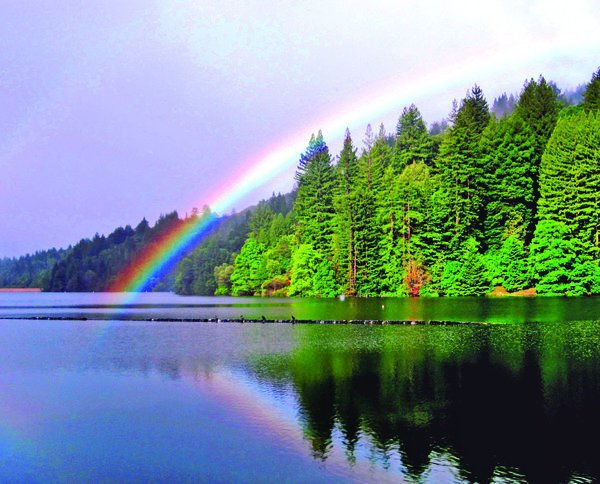This year, Loch Lomond never opened. There was no children’s laughter or the sight of kayaks cutting through alpine waves or a fisherman in a bucket hat decorated with lures. The fish are jumpin’ but there is no one to catch them.
There is a nesting pair of ospreys and bald and golden eagles but none to see them except the few rangers constructing fire brakes.
We will have the unique opportunity to explore Loch Lomond on our next watershed walk with Chris Berry, Santa Cruz Water Compliance Manager; Fred McPherson, former San Lorenzo Valley Water District Director, and the new Chief Ranger Gar Eidam on Saturday, Aug. 16.
Berry’s job during the drought is like a tightrope act — unpredictable, focused, and challenging. How much water can we save for fish and how much water should we save for humans? The scenario is being played out all over Northern California.
In “normal” times, water is diverted from the San Lorenzo River and the North Coast to the Loch Lomond reservoir. But water levels have gone down and, in order to avert a fish kill, customers have been asked to ration and no water is being diverted.
“That’s why the reservoir is so low,” says Berry. “When we meet at Loch Lomond, you’ll see the big bathtub ring, and you’ll know that’s why there are so many fish in the river and the North Coast. As a result, we’re taking more out of Loch Lomond. The only certainty I have is that we’re going to be tighter and more challenged in regard to fish.”
The Felton resident says: “I’m happy to say that we’re doing better than we expected in terms of our supply planning for the summer. I’m not happy when I think about a potential next dry year. The El Nino predictions for next year have all been discredited so we don’t have any expectations that we’re going to have a wet year next year.”
While much of Santa Cruz County is dotted with “Doing Our Part to Save Water” signs, I’ve noticed water mismanagement in agribusiness. Several times a month, I travel Highway 1 to serve as a docent for the Pacific Grove Natural History Museum and I go through miles of farmlands that are wasting water.
As you know, 80 percent of our state’s water is used for agriculture, but instead of using drip irrigation — the most water-efficient method because it minimizes evaporation and runoff — farmers continue to use antiquated, water-guzzling overhead irrigation that sends water into the air with high-pressure sprinklers. This system causes dehydration, and many sprinklers don’t work, spewing plumes of water into gullies.
Farmers are also watering during daylight. I lived in West Texas for several years where heat and drought are normal and irrigation systems were timed to come on only at night, lessening dehydration.
Santa Cruz County has invested in “water cops” to watch our patches of lawn, but the State needs to patrol farmlands and save our most precious natural resource. Shortened showers aren’t even a drop in the bucket.
For Gar Eidam, the drought is personal. Ever since he became Chief Ranger, the park has been closed.
“I do miss the public, the families coming in to picnic and fish on a daily basis, but more animals have been coming in for the water,” says Eidam. “We’ve seen a couple of juvenile mountain lions.”
During the closure, he and his team have been busy doing deferred maintenance, including fire protection, throughout the 5,000 acres, and “making it pretty for next winter when the rain comes so the public can enjoy it,” the Chief says, “I’m looking forward to this walk and meeting our San Lorenzo (Valley) neighbors and hearing what they have to say about Loch Lomond.”
Fred McPherson will share a historical perspective about Loch Lomond and how it is not being used effectively because it lacks a well-integrated system of water use. Water rights were handed out in pieces to disparate agencies, like Scotts Valley, San Lorenzo Valley, Lompico, and the city and the county of Santa Cruz as the population grew and needs changed.
“The use of the water has not been coordinated before, but now John Ricker, the County’s water resources director, is trying to come up with an overall water use plan for the County,” says the nature videographer.
The walk is free and sponsored by a grant from the San Lorenzo Valley Water District. For more information, contact me at ca****@*********on.com.
– Carol Carson is a writer and Certified California State Master Naturalist.













